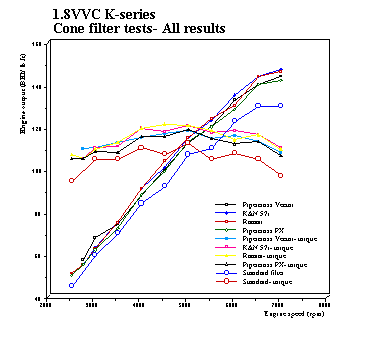 |
1.8 litre, VVC K series. |
Typical installions: MGF, Lotus Elise 111S, Rover 218vi
 |
Figure 1. All the cone filter data illustrated. A difficult figure to read this one, but I would draw your attention to the lines with the open circles (blue and red). These are the standard power curves. As can be seen, the all the cone filters make a clear gain over standard in both power and torque. The four filters put themselves into two groups: those with a spacer tube between the filter and the throttle body, and those that are clamped directly to the throttle body. Within these two groups, the filters are indiscerbable from their power curves. The filters with spacer tubes have a clear advantage over those that don't. (K&N and Ramair versus the two Pipercross products). |
Conclusions of the VVC cone filter tests:
The K&N and Ramair products clear gave the best performances. Factor in costs, and the K&N clearly wins the contest between these two filters. However, at 0.15 bhp per pound versus the impressive 0.3 bhp per pound of the Pipercross product, is the K&N worth it? Ultimately that is a decision that lies in the hands of the prospective purchaser. Given the clear power advantage of the K&N the investigators were happy to give this product the thumbs up.
One further consideration is that of induction temperature. The higher the temperature of the air entering the engine, the less dense, and therefore, the less oxygen that the air contains for combustion. A lower temperature is desirable for more power. These rolling road tests were performed with the intake temperatures equalised for each filter tested. Both the K&N and the Ramair filters come with cooling ram ducts to cool the filters' intake charge; the Pipercross filters do not come with this refinement. Investigations with temperature probes have revealed that under normal driving conditions the Pipercross filters would suck in air up to 10 celcius or more than the K&N or Ramair filters. This would effectively abrogate any advantage the Pipercross filters might convey. Therefore it is advantage K&N.